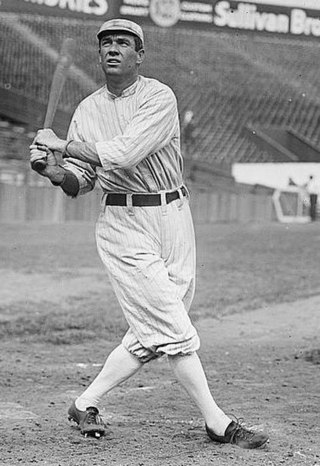
Tristram Edgar Speaker, nicknamed "the Gray Eagle", was an American professional baseball player and manager. He played in Major League Baseball (MLB) as a center fielder from 1907 to 1928. Considered one of the greatest players in the history of Major League Baseball, he compiled a career batting average of .345. His 792 career doubles represent an MLB career record. His 3,514 hits are fifth in the all-time hits list. Defensively, Speaker holds career records for assists, double plays, and unassisted double plays by an outfielder. He held the major league career record for putouts by a center fielder (6,592) until he was surpassed by Willie Mays in 1971. His fielding glove was known as the place "where triples go to die."

Howard Ellsworth "Smoky Joe" Wood was an American professional baseball player for 14 years. He played for the Boston Red Sox from 1908 to 1915, where he was primarily a pitcher, and for the Cleveland Indians from 1917 to 1922, where he was primarily an outfielder. Wood is one of only 13 pitchers to win 30 or more games in one season since 1900.
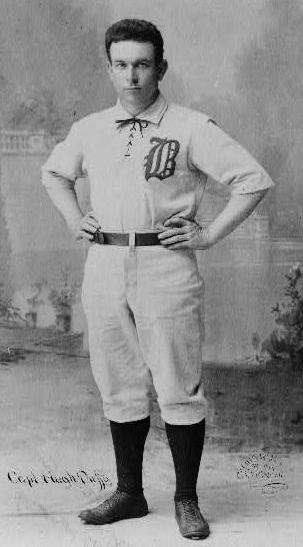
Hugh Duffy was an American outfielder and manager in Major League Baseball. He was a player or player-manager for the Chicago White Stockings, Chicago Pirates, Boston Reds, Boston Beaneaters, Milwaukee Brewers and Philadelphia Phillies between 1888 and 1906. He had his best years with the Beaneaters, including the 1894 season, when he set the National League single-season record for batting average (.440), a record that has stood for over a century.
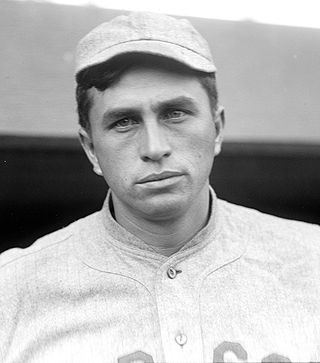
Harry Bartholomew Hooper was an American professional baseball right fielder who played in Major League Baseball (MLB). Hooper batted left-handed and threw right-handed. Hooper was born in Bell Station, California, and he graduated from Saint Mary's College of California. He played for major league teams between 1909 and 1925, spending most of that time with the Boston Red Sox and finishing his career with the Chicago White Sox.

George Edward "Duffy" Lewis was an American professional baseball left fielder who played in Major League Baseball (MLB) for the Boston Red Sox, the New York Yankees, and the Washington Senators from 1910 to 1921.
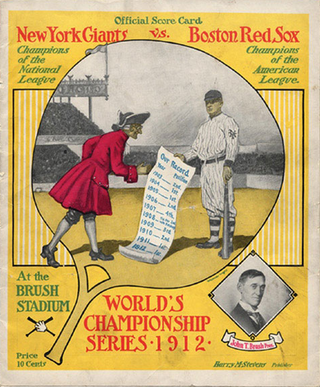
The 1912 World Series was the championship series in Major League Baseball for the 1912 season. The ninth edition of the World Series, it matched the American League champion Boston Red Sox and the National League champion New York Giants. The Red Sox won the Series four games to three.

The 1915 World Series was the championship series in Major League Baseball for the 1915 season. The 12th edition of the World Series, it matched the American League champion Boston Red Sox against the National League champion Philadelphia Phillies. The Red Sox won the Series four games to one. It was the last World Series to start on a Friday until the 2022 World Series.
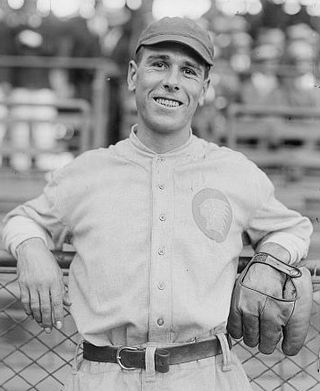
Frederick Carlisle Snodgrass was an American center fielder in Major League Baseball from 1908 to 1916. He is best known for dropping a key fly ball in the 1912 World Series.
The following are the baseball events of the year 1958 throughout the world.
The following are the baseball events of the year 1951 throughout the world.

Robert Hayes Veach was an American professional baseball player from 1910 to 1930 including 14 seasons in the major leagues. He was the starting left fielder for the Detroit Tigers from 1912 to 1923 and also played for the Boston Red Sox (1924–1925), New York Yankees (1925), and Washington Senators (1925).

Olaf Henriksen was a Major League Baseball outfielder who remains to date the only Danish-born person ever to play in the major leagues. He played seven seasons (1911–17) for the Boston Red Sox as a teammate of Hall of Famers Babe Ruth and Tris Speaker, among others, and he played a role in three World Series victories, namely in 1912, 1915 and 1916.

William Chester "Baby Doll" Jacobson was an American baseball outfielder. He played 11 seasons of Major League Baseball, principally with the St. Louis Browns, between 1915 and 1927. He also played for the Detroit Tigers (1915), Boston Red Sox (1926–1927), Cleveland Indians (1927), and Philadelphia Athletics (1927).

The 1910 Boston Red Sox season was the tenth season in the franchise's Major League Baseball history. The Red Sox finished fourth in the American League (AL) with a record of 81 wins and 72 losses, 22+1⁄2 games behind the Philadelphia Athletics, who went on to win the 1910 World Series. The team played its home games at Huntington Avenue Grounds.

The 1911 Boston Red Sox season was the 11th season in the franchise's Major League Baseball history. The Red Sox finished fourth in the American League (AL) with a record of 78 wins and 75 losses, 24 games behind the Philadelphia Athletics, who went on to win the 1911 World Series. This was the final season that the Red Sox played their home games at Huntington Avenue Grounds, before moving to Fenway Park.

The 1912 Boston Red Sox season was the 12th season in the franchise's Major League Baseball history. This was the first year that the team played its home games at Fenway Park. The Red Sox finished first in the American League (AL) with a record of 105 wins and 47 losses. The team set the franchise record for highest winning percentage (.691) in a season, which still stands; tied the franchise record for fewest losses in a season, originally set by the 1903 team; and set a franchise record for most wins, which was not surpassed until the 2018 club.

Arthur Clyde "Hack" Engle was a utility player who played in Major League Baseball between 1909 and 1916. Listed at 5' 10", 190 lb., Engle batted and threw right-handed. He was born in Dayton, Ohio.

Walter Phillip Rehg was a reserve outfielder in Major League Baseball, playing mostly as a right fielder for four different teams between the 1912 and 1919 seasons. Listed at 5 ft 8 in (1.73 m), 160 lb., Rehg batted and threw right-handed. He was born in Summerfield, Illinois.

The $100,000 infield was the infield of the Philadelphia Athletics in the early 1910s. The $100,000 infield consisted of first baseman Stuffy McInnis, second baseman Eddie Collins, shortstop Jack Barry and third baseman Frank "Home Run" Baker. According to the Encyclopædia Britannica, the nickname reflects "the purported combined market value of the foursome", which is equivalent to about $2.38 million in 2023.
The Portland Duffs were a minor league baseball team based in Portland, Maine. From 1913 to 1915, the Portland "Duffs" played as members of the Class B level New England League, winning the 1915 league championship.
















